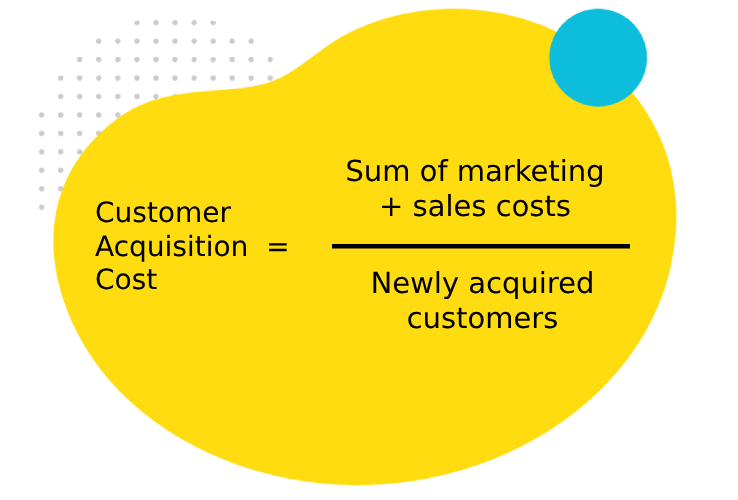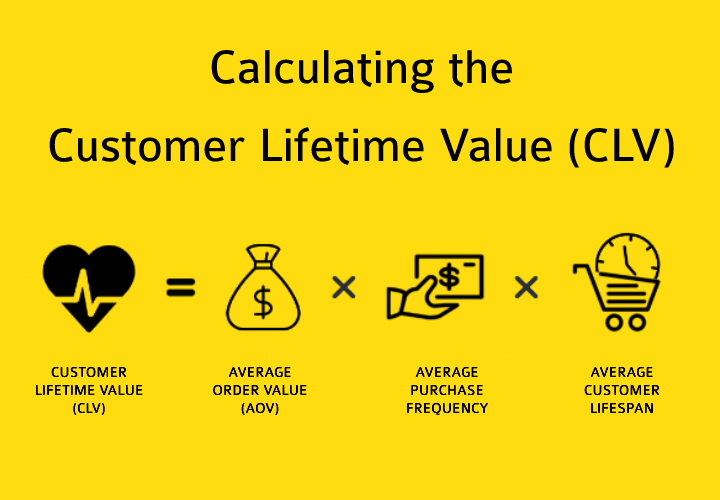4 E-commerce Trends in 2026
What will the biggest e-commerce trends be in 2026? Artificial Intelligence will clearly play a big role. We explore those trends with 4 predictions.

The Customer Acquisition Cost (CAC) helps online shop owners gauge the effectiveness of their efforts, particularly when it comes to sales and marketing. Lowering CACs should be a goal of any online shop owner. Today, we'll dive deeper into the topic of customer acquisition.
We'll cover the following topics:
Table of contents:
Let’s first look at what the exact definition of Customer Acquisition Cost is, why it is so important for shop owners, and how to calculate it
CAC stands for Customer Acquisition Cost. It refers to the amount of money spent by a company to acquire a new customer within a specific time period.
When considering the factors that go into calculating your CAC, the costs of sales and marketing as well as the number of new customers acquired are part of the equation.
By becoming aware of your CAC, you are opening your company up for improvement. By improving your CACs, you ensure that more of your revenue is profits.
Acknowledging what the costs of acquisition are and proactively trying to optimise it is an important step in making sure your company is running smoothly, efficiently, and most importantly, sustainably.
As we mentioned in the intro, lowering the CAC should be a goal for any shop owner and optimisation is the name of the game.
You'll need to investigate other key metrics and KPIs in the process. Knowing some of the other KPIs will give context to your CACs and optimising some of these other metrics will help you reduce your cost per acquisition. We'll touch on some of these strategies shortly.
Let's begin with the actual formula for figuring out the cost of acquisition:
The cost of acquisition is calculated by adding up the costs of your sales and marketing efforts within a certain period of time. Then, take this sum and divide it by the number of new customers in that same period of time.

The formula itself is quite simple in terms of calculations, but figuring out your marketing and sales costs can be a bit tricky. Let's have a look at some factors you'll want to consider when you're going through your numbers.
When adding up your sales and marketing costs, there are a number of factors to consider:
If you hire employees to do sales and marketing for your company, they should be factored into your calculations. If you're a small company, some people have multiple positions, so only factoring a portion of their salary might make sense in your situation. Either way, salaries are definitely part of the equation.
This can include content writers, sales people, designers, and any other people who spend the majority of their time either collecting leads or converting them into customers.
Whether you run Google Ads, social media ads, influencer marketing campaigns, or anything else that requires you to spend money to get your brand out there, you'll want to factor these costs into your CAC calculation.
Do you hire an external SEO consultant? Do you use software to build your website? Did you buy gear in order to take unique product images or shoot videos? What about that workshop your sales team went through?
These are all costs to consider when you're taking stock of your costs.
Here are a few examples of how an online shop might calculate their CACs. We'll focus on B2C shops in these examples, but the concepts apply to any type of business:
For a small B2C, their workforce will probably be quite small. In fact, in this case, it is a ‘one-man operation’, so no salaries will be factored in. However, the company still uses Shopify to build their site along with some other software to track and automate some features (about £300).
Since we are looking for a monthly breakdown, we should consider the shop owner's ad budget for the month in question: £1,500. They also take their own product images and write their own texts. Costs are quite low overall.
Through their efforts, this shop got 30 new customers that month.
Calculating their CAC for the month:
CAC = (£300 + £1,500) ÷ 30 = £1,800 ÷ 30 = £60
The owner of this shop spent about £60 for every new customer in that time frame.

Shutterstock/fizkes
For a medium-sized business, there are more factors to consider. Let’s do a quarterly calculation for this shop. This company, has two dedicated sales people and one marketing manager. Their quarterly salaries are equal to about £36,000 combined for the quarter.
Software for their company costs cost about £500 per month (£1,500 per quarter).
This company has a bigger marketing budget and spent £10,000 on ads this past quarter.
The shop managed to get 1,200 new customers in the quarter.
Calculating their CAC for the quarter:
CAC = (£36,000 + £1,500 + £10,000) ÷ 1,200 = £47,500 ÷ 1,200 = £39.58
This shop spent nearly £40 for every new customer during that quarter.
For this last example, let's look at the acquisition costs for a large-sized company for an entire year. With a sales team of 10 people and a marketing team of three, annual salaries cost the company about £700,000.
Software, employee trainings, and outsourcing cost the company £12,000.
With a big marketing budget, the company spent about £300,000 on marketing campaigns last year.
They did business with 12,500 new customers last year.
Calculating their CAC for the past year:
CAC = (£700,000 + £12,000 + £300,000) ÷ 12,500 = £1,012,000 ÷ 12,500 = £80.96
This online shop spent nearly £81 for every new customer last year.
Now that you know how to calculate the cost per acquisition, you’ll need to know what do with it. Of course, you'll want to look at your profit margins, but there are many key metrics and KPIs that you should pay attention to. Figuring out how they relate to each other is the next step.

Shutterstock/Odua Images
You've surely heard that ‘it costs less to sell to returning customers than it is to acquire new ones’. This saying has been around for a long time. The numbers back up this claim and it makes sense: once a customer has bought from you, they are much more likely to buy from you again.
Of course, this depends on a few factors, but simply put: if you provide a good shopping experience, customers will come back to you.
It might sound obvious, but you need new customers in order to turn them into returning customers.
Acquiring new customers means your company (and your brand!) is growing. Once these new customers are in your system, you should work on getting them to come back. Every time they come back spend more money with you, you are getting more from your investment (i.e. your acquisition costs).
Because of this, it is common to use your Customer Lifetime Value (CLV a.k.a. LTV) metric to bring more context to your CACs. We've written a blog article dedicated to the topic:
Recommended reading:
Customer Lifetime Value: 8 Tips to Improve It
In short, the Customer Lifetime Value is the total value of income that a customer brings to your business over the entire duration of the business relationship.
You calculate it by multiplying the average order value by the average purchase frequency and the average customer lifespan.

Many shop owners look at the ratio between the CLV and the CAC. As a general rule, you should be aiming for a 3:1 ratio. That would mean that your customers are bringing in three times the amount of money that you spent on acquiring them.
Conversion rates are always a broad topic, but this is a great place to start when looking to improve your CACs. It's still worth a quick overview here, so we're clear on what conversion rates mean.
In e-commerce, conversions often refer to the number of customers you've ‘converted’. Convert can mean many different things, but in e-commerce, we often mean the percentage of site/page vistors who have converted into customers.
However, there are a lot of stats that take this basic formula:
Conversion rate = number of users who completed a specific action / total number of users
From this basic concept, we can look at micro conversions, such as:
Despite not necessarily only looking at customer conversions, you can look at other elements of your marketing activities such as email conversion rates or form-filling conversion rates, etc.
Recommended reading:
How to Calculate and Boost Your Conversion Rates
Every business is going to be different. Even shops that are in the same industry have different offerings, different supply chains, different costs of running the business. However, it's still helpful to know that in the world of e-commerce, the average cost per acquisition is $70.
First Page Sage has provided some information regarding average CAC for e-commerce companies by industry:
|
Industry |
Average CAC |
|
Advertising Specialty / Promotional |
$64 |
|
Automotive Parts |
$78 |
|
Beauty / Personal Care |
$61 |
|
Cannabis / CBD |
$72 |
|
Consumer Electronics |
$76 |
|
Household Goods |
$58 |
|
Fashion / Apparel |
$66 |
|
Food & Beverage |
$53 |
|
Furniture |
$77 |
|
Jewelry |
$91 |
|
Medical |
$87 |
|
Sporting Goods |
$67 |
|
Toys / Hobbies / DIY |
$59 |
We now know what customer acquisition costs mean, how to calculate them, and how to give them context. Now to the best part: how to decrease them.
The key factor here is a word you've probably heard again and again: optimisation.
It's important to remember that this is the biggest factor in improving your CACs. After all, it's a long-term goal that you will revisit constantly, so having that kind of mindset will be beneficial to how you view and achieve success.
It's worth starting at the core of your business: your customers.
Every now and then, it's worth revisiting the idea of who your customers really are. Many businesses begin with one target audience in mind, but end up with a different one after time passes.
Your data will be invaluable here. Knowing your key demographics and their behaviour is vital to optimisation.
Have you ever thought about who your ideal customer is? It might make sense to create a buyer persona. By creating a ‘portrait’ of your ideal customer, you'll know who they are and what they do. A typical buyer persona contains information like:
There may be even more information than that. The point is that this kind of customer description can be helpful to both your sales teams and your marketing teams.
You might realize that your ad spend on Facebook is too high since 70% of your customers are aged 18-25 and are therefore more active on Instagram.
Alternatively, you might realise that the sound and feel of your website is catered more towards an older crowd. It might be time to freshen things up a bit.
You might even discover that you can segment your customers into smaller groups. Therefore, multiple buyer personas might make sense for your company.

Shutterstock/3rdtimeluckystudio
By knowing more about your customer, you'll have a good starting point as to where you can begin making adjustments (ahem; optimisations). Let's take a closer look at some actions you can take...
Once you have a good feel for who your customer really is, it's time to take that analytical eye and figure out what you can optimise from a marketing perspective. Once again, you'll want to make note of your data and your key metrics.
It's worth mentioning the concept of A/B testing first because it can be applied to almost any aspect of your marketing. We've covered A/B tests in detail in the link below, but the main concept is to test one element of your marketing content at a time.
For example, if you run an Instagram campaign, run two ads that are identical except for the headline. You could test out a question (e.g. Are you ready for Winter?) vs. a positive statement (e.g. Get ready for Winter!). You can even test a third or a fourth headline: a negative statement (e.g. Don't get left out in the cold...) vs. a negative question (e.g. Don't have a jacket yet?).
After you've settled on a headline, make some small tweaks to the images and test those as well.
Do this with email subject lines, product descriptions, social media ads, Buy now buttons, etc. There are endless things you can A/B test, so keep this in mind with each section we cover below.
Recommended reading:
What is A/B Testing and Why Your Online Shop Should Be Doing It
You’re A/B tests can begin on your website. You can test your calls-to-action, your headlines, product images, and product descriptions. The possibilities are seemingly endless.
Having a deep dive on your website and the customer journey can be insightful. Some questions you might ask yourself include:
Does your homepage drive people to the right places?
Is your current sale visible enough?
Does the design fit my audience?
Are there spelling mistakes on my site?
Does my site build trust at first glance?
Am I asking for too much data in the checkout process?
There are a lot of things to consider that A/B tests might not reveal. You might even want to get an ‘outsider's’ perspective. Focus groups are a possibility. There are expensive and cheap options for this, but don't forget to add it to your costs when doing your CAC calculation.
The idea here is that you want to boost those conversion rates. This will benefit your ads campaigns (more on that below), which will improve your customer acquisition cost.
 Communicating your trustworthiness is a great way to improve conversions. Displaying reassuring certificates can achieve this. The Trusted Shops Trustmark offers consumers a 30-day Buyer Protection and shows users that a trustworthy 3rd party has given it the proverbial thumbs-up. Next to the Buyer Protection, a customer review rating shows that consumers have had great experiences with you as well.
Communicating your trustworthiness is a great way to improve conversions. Displaying reassuring certificates can achieve this. The Trusted Shops Trustmark offers consumers a 30-day Buyer Protection and shows users that a trustworthy 3rd party has given it the proverbial thumbs-up. Next to the Buyer Protection, a customer review rating shows that consumers have had great experiences with you as well.
Alongside service reviews, product reviews on your product pages can also boost conversions. By displaying your product reviews directly on your website, you'll avoid users opening a new tab to find reviews elsewhere. The last thing you want users to do is leave your website in order to find reviews and then discover a competitor's site.
Besides reviews and trustmarks, you can also include an About Us page to your website.
Make sure your contact info is easily found on every page of your website.
The key to building trust is being transparent.
Curious to see if your shop can earn the Trustmark? Check out the Certification Quick Scan below:
Ad campaigns are the perfect place to try to make more out of your marketing budget.
A/B tests are made for ad campaigns. In fact, many platforms have A/B testing features built in.
You can, for example, test:
different headlines in your ads and connected landing pages
images
links
audience targeting
Besides running A/B tests in your campaigns, it might make sense to check up on the keywords you're using.
Are you using long-tail keywords?
What about negative keywords?
Do the keywords you're targeting really fit both your audience and your landing page?
Are any keywords leading to unwanted/ineffective traffic?
By optimising your keyword game and other aspects of your ad campaigns, you'll get better leads to your shop. And better leads mean better conversion rates.
Most advertising platforms reward advertisers that achieve good conversion rates by lowering their cost-per-click (CPC), effectively making their ads cheaper. This will allow your marketing budget to go even further than it does now.
💡 Tip: Collecting Google-certified customer reviews will allow you to display star-ratings throughout Google, which has been proven to improve click-through rates. Learn more about the Google-certified Trusted Shops Reviews platform.
Speaking of keywords, content marketing is a great way to drive organic traffic to your site. Sure, you can pay for Google Ads so your brand appears at the top of relevant searches. However, getting to the top of a search results page (SERP) for free can be worth the effort.
Not only do you get free traffic, but you'll build a certain level of trust by appearing towards the top of the results while strengthening the rankings of your entire domain.
If you can rank on the first page for relevant keywords and drive hundreds (or thousands) of users to your site for free, think of the thousands you'll save from your marketing budget.
If you work in a niche industry, you can create targeted content that might lead users of that niche to discover your website/products naturally.
For example, if you sell rock'n'roll memorabilia, you could write a blog about the best tours of the 1970s. Share quotes, stories, and images in your article. When it comes to images, show pictures of the band, the fans, and the souveniers from the shows. Then, casually link to some product pages that you think are fitting to that article/band.
By focussing on phrases such as ‘the best band tours of the 70s’ and ‘best rock concerts of 1970s’ (and other such keyword phrases) rather than ‘concert memorabilia’ for this particular article, you might get the attention of users who weren't initially looking for a product.
Even if you don't get an insane amount of customers from that article, having a high ranking page like that can still bring SEO benefits to your site as a whole. The trick to ranking high is to make sure your content is actually worth reading while focusing on the right keywords. Making good content may require some time and effort, but the effects can be worth it.
Recommended reading:
Content Marketing: Boosting Sales for Online Shops
If you already have a content marketing plan in place to drive organic traffic to your site, you should take a closer look at your performance. Are blog articles that were once effective now losing traffic? Time for an update!
Update your images (decreasing their size with tools like TinyPNG for faster loading speeds)
Freshen up the texts with new statistics and expanded info
Do keyword research and see if you can add more relevant keywords to your content (without spamming them)
It makes sense to check out your email campaigns from time to time, especially after you've reviewed and adjusted your buyer personas. Some questions to ask yourself:
Are you ‘speaking the customer's language’? Know your audience and adjust your tone and word choice.
Are you pushing your products too hard (or not hard enough)? Finding the right balance can be tricky. Consider the expectations of your readers.
Are your emails too long? Tighten up your texts.
How are your open rates? Is it time to freshen up your subject lines?
How are your click-through rates? Consider using new wording.
Are the right people getting the right emails? Segment your emails correctly.
It all depends on the types of emails you’re sending out. Newsletters are different than discount notifications and product release emails. You don't want to mix and match the goals of each campaign too much, but some emails can promote your products a bit more than others. Context matters.
No matter what the goals of your email campaigns are, they can always use some freshening up and A/B tests are great for email campaigns as well.
Improving your Customer Acquisition Costs can be challenging, but there are many opportunities for you to look at your sales and marketing efforts and see where you can improve. By getting an overview of your activities, you can begin the first steps towards reaching that goal.
15/12/23What will the biggest e-commerce trends be in 2026? Artificial Intelligence will clearly play a big role. We explore those trends with 4 predictions.
SEO is an important tool for e-commerce businesses to bring in new customers. Here are the best tips for your online shop to rank higher in Google.